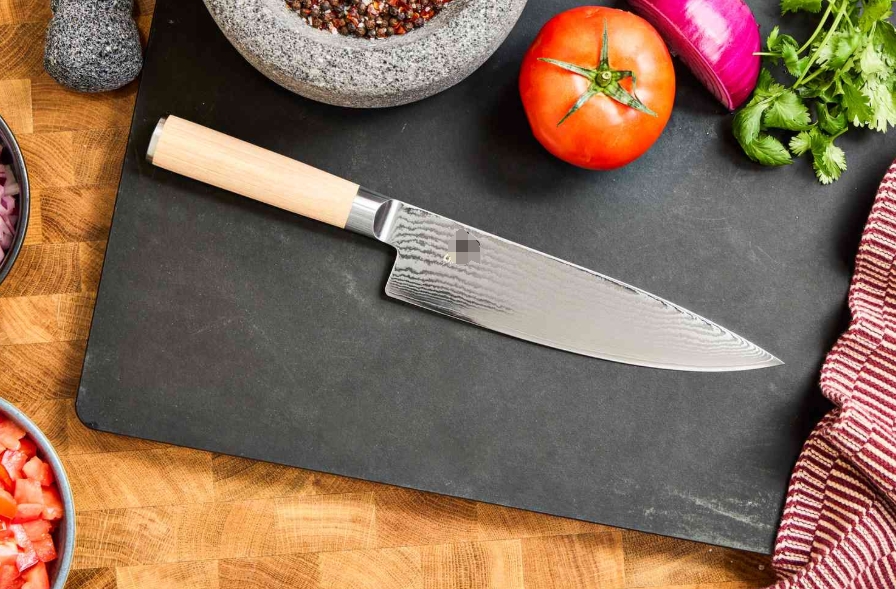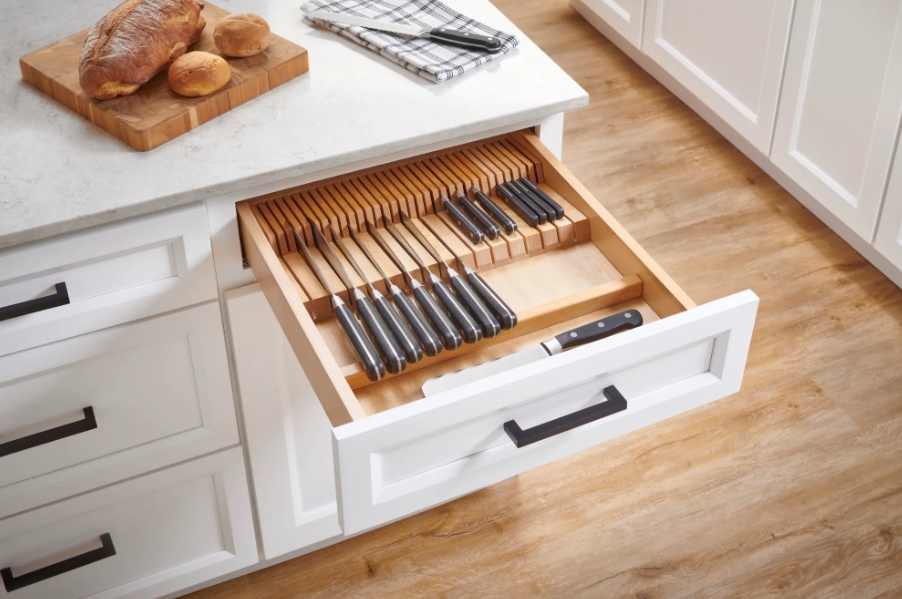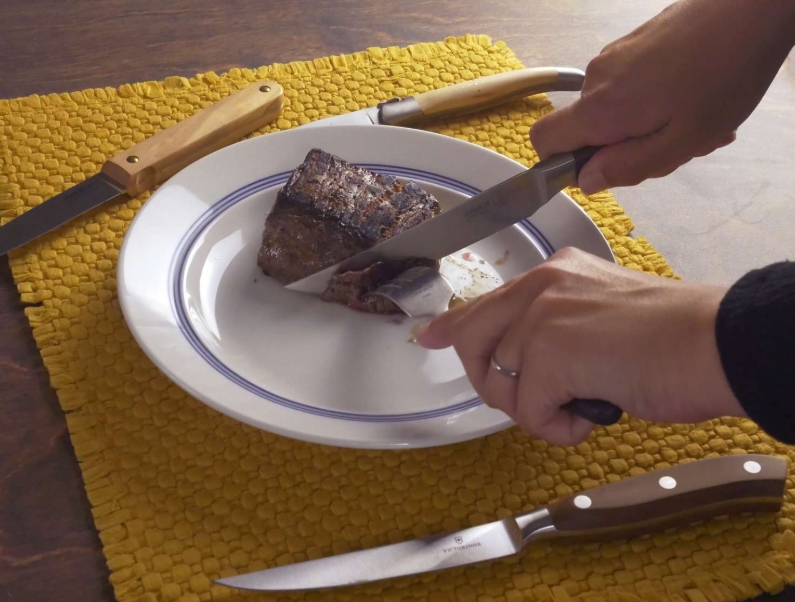

Views: 222 Author: Ella Publish Time: 2025-04-24 Origin: Site








Content Menu
● How Are Stamped Knives Made?
● Key Differences: Forged vs. Stamped Knives
● Pros and Cons of Forged and Stamped Knives
● Performance in the Kitchen: Which Is Better?
● Price and Value Considerations
>> How a Stamped Knife Is Made
● FAQ
>> 1. What is the main difference between forged and stamped knives?
>> 2. Are forged knives always better than stamped knives?
>> 3. How can I tell if a knife is forged or stamped?
>> 4. Which type of knife is easier to maintain?
>> 5. Should I buy a forged or stamped knife set?
Choosing the right kitchen knife set is essential for both professional chefs and home cooks. Among the most common debates is whether to invest in a forged or stamped knife set. Each type offers unique advantages, construction methods, and characteristics that can significantly impact your cooking experience. In this comprehensive guide, we'll explore the differences between forged and stamped knives, their pros and cons, and help you make an informed decision for your kitchen.

When shopping for kitchen knives, you'll encounter two main types: forged and stamped knives. The distinction lies in their manufacturing process, resulting in differences in weight, balance, durability, and price. Understanding these differences is crucial for selecting the best knife set for your needs[1][2][3].
Forged knives are crafted from a single bar of steel, which is heated until red-hot and then pounded or pressed into shape. This process can be done by skilled artisans or advanced machines. After shaping, the blade undergoes quenching and tempering, which strengthens and hardens the metal[1][10][12].
Key Features of Forged Knives:
- Bolster: A thick junction between the blade and handle, providing balance and safety.
- Full Tang: The metal extends the entire length of the handle, enhancing strength and stability.
- Thickness and Weight: Forged knives are generally thicker and heavier, offering a solid, balanced feel[1][9][10].
- Edge Retention: The forging process compresses the steel's molecules, resulting in superior edge retention and durability[12].
Stamped knives are cut from large sheets of steel, similar to how a cookie cutter works. The blade is then heat-treated and honed for sharpness. This process is faster and more cost-effective than forging, making stamped knives more affordable[2][9][10].
Key Features of Stamped Knives:
- No Bolster: Most stamped knives lack a bolster, making them lighter but less balanced.
- Partial Tang: The tang may not extend the full length of the handle, affecting strength and stability.
- Thin and Lightweight: Stamped knives are thinner and more flexible, suitable for tasks requiring maneuverability[2][9][10].
- Affordability: The simpler manufacturing process results in a lower price point[3][10].
| Feature | Forged Knives | Stamped Knives |
|---|---|---|
| Manufacturing | Heated and hammered from a single steel bar | Cut from a large sheet of steel |
| Weight | Heavier, more balanced | Lighter, easier to maneuver |
| Bolster | Usually present, adds safety and balance | Rarely present, less balance |
| Tang | Full tang (extends through handle) | Often partial tang |
| Durability | More durable, resists bending | Less durable, more flexible |
| Edge Retention | Holds edge longer, requires less frequent sharpening | Needs more frequent sharpening |
| Price | Higher, reflects craftsmanship | More affordable, mass-produced |
| Ideal Use | Heavy-duty, precision tasks | Light, repetitive, or delicate slicing tasks |
Pros:
- Superior durability and strength[3][9][10]
- Excellent balance and control due to bolster and full tang[1][9]
- Retain sharpness longer, less frequent sharpening required[2][12]
- Suitable for heavy-duty tasks and professional use
Cons:
- Heavier, which may cause fatigue during extended use[9][3]
- Higher price point due to labor-intensive manufacturing[3][10]
- May require more skill to maintain and sharpen[3]
Pros:
- Lightweight and easy to handle, ideal for repetitive or delicate tasks[2][3][9]
- More affordable, accessible to beginners and budget-conscious cooks[3][10]
- Flexible blades, great for filleting fish or garnishing[3][9]
- Easier to sharpen and maintain for novices[3]
Cons:
- Less durable, may bend or break under heavy use[3][9][10]
- Often lacks balance and finger protection due to absence of bolster[9][10]
- May need to be replaced more frequently, increasing long-term costs[3]

The choice between forged and stamped knives depends on your cooking style and needs:
- Forged knives excel in tasks requiring power, precision, and durability, such as chopping dense vegetables, slicing meat, or mincing herbs. Their weight and balance provide control and safety, especially for professional chefs and serious home cooks[9][10].
- Stamped knives are perfect for lighter tasks, such as slicing bread, filleting fish, or preparing garnishes. Their flexibility and lightness reduce fatigue during extended use, making them suitable for beginners or those who prefer a less hefty tool[2][9].
Forged knives are generally more expensive due to the labor-intensive process and materials used. However, their durability and longevity can make them a better long-term investment, especially for those who cook frequently or professionally[3][10][5][11].
Stamped knives, on the other hand, are budget-friendly and ideal for those just starting out or who need a set for occasional use. They offer good value for money but may require more frequent replacement if used heavily[3][10].
Forged Knives:
- Require regular honing and occasional sharpening to maintain their edge.
- With proper care, they can last a lifetime, making them a worthwhile investment for dedicated cooks[4][11].
Stamped Knives:
- Easier to sharpen but may dull more quickly.
- Less robust, so they may not withstand heavy use over time, leading to more frequent replacements[3][9][10].
The debate between forged and stamped knives centers on the balance between durability, performance, and price. Forged knives are the top choice for those seeking longevity, strength, and precision, making them ideal for professionals and dedicated home cooks. Stamped knives, meanwhile, offer lightweight handling, flexibility, and affordability, making them a practical option for beginners or those on a budget.
Ultimately, the best knife set is the one that suits your cooking habits, preferences, and investment level. Many chefs recommend having both types in your kitchen to cover a wider range of tasks[4]. By understanding the differences, you can confidently select the knives that will best serve your culinary needs for years to come.

Forged knives are made from a single bar of steel that is heated and hammered into shape, resulting in a thicker, heavier, and more durable blade with a bolster and full tang. Stamped knives are cut from a sheet of steel, making them lighter, more flexible, and generally less expensive, but also less durable and balanced[1][2][9].
Not necessarily. Forged knives offer superior strength, balance, and edge retention, but their heavier weight and higher price may not suit everyone. Stamped knives are ideal for light, repetitive tasks and are more affordable, making them suitable for beginners or those who prefer lightweight tools[3][10].
Look for a bolster (the thick junction between the blade and handle) and a full tang (metal running through the handle) in forged knives. Stamped knives usually lack a bolster and may only have a partial tang. The weight and thickness of the blade can also be indicators[1][2][9].
Stamped knives are generally easier to sharpen due to their thinner blades, but they may require more frequent sharpening. Forged knives hold their edge longer but may need more skill to maintain properly[3][9][10].
Your choice should depend on your cooking style, frequency, and budget. If you prioritize durability and precision, invest in a forged set. If you want affordability and lightweight handling, a stamped set may be better. Many cooks find value in owning both types for different kitchen tasks[4][9].
[1] https://www.thespruceeats.com/what-is-a-forged-knife-what-is-a-stamped-knife-908924
[2] https://theforgedblade.com/blogs/articles/stamped-vs-forged-knives
[3] https://www.cooksdirect.com/stamped-vs-forged-knives-weighing-the-pros-and-cons
[4] https://www.koiknives.com/blogs/knife-steel-index/forged-and-stamped-knives-which-one-is-right-for-you
[5] https://www.all-clad.com/forged-knives.html
[6] https://totaste.com/how_tos/forged-vs-stamped-knives/
[7] https://www.youtube.com/watch?v=zrlWkNc8aGA
[8] https://www.youtube.com/watch?v=ONRcLsNl9-0
[9] https://rydaknives.com.au/blogs/news/deciding-between-forged-and-stamped-knives-understanding-the-key-differences
[10] https://madeincookware.com/blogs/what-is-the-difference-between-fully-forged-vs-stamped-knives
[11] https://www.tramontina.com/products/professional-3-piece-forged-essential-knife-set
[12] https://lamsonproducts.com/faq/whats-the-difference-between-a-forged-laser-cut-and-stamped-knife-blades/
[13] https://www.montanaknifecompany.com/blogs/news/forged-knives-vs-stamped-knives
[14] https://lamsonproducts.com/faq/whats-the-difference-between-a-forged-laser-cut-and-stamped-knife-blades/
[15] https://www.vikingculinaryproducts.com/products/viking-10-piece-true-forged-cutlery-set-with-block
[16] /what-s-the-difference-between-forged-and-stamped-kitchen-knives.html
[17] https://sirenasystem.com/blog/difference-between-fully-forged-vs-stamped-knives/
[18] https://brownskitchen.com/blogs/ask-the-experts/how-to-choose-the-perfect-kitchen-knife-for-your-cooking-style
[19] https://us.santokuknives.co.uk/blogs/blog/forged-vs-stamped-what-s-the-difference
[20] https://www.williams-sonoma.com/shop/cutlery/forged+knife-sets/features-m-features-ff0011-1/
[21] https://www.williams-sonoma.com/shop/cutlery/stamped+knife-sets/features-m-features-ff0012-1/
[22] https://santokuknives.co.uk/blogs/blog/forged-vs-stamped-what-s-the-difference
[23] https://www.bbq-brethren.com/threads/forged-or-stamped-knives-help-me-decide-on-a-set.78615/
[24] /forged-knife-set-vs-stamped-knife-set-what-s-the-better-choice.html
[25] https://cangshancutlery.com/products/cangshan-l-series-1027440-german-steel-forged-10-piece-knife-block-set
[26] https://www.shutterstock.com/search/forged-knife
[27] https://madeincookware.com/blogs/what-is-the-difference-between-fully-forged-vs-stamped-knives
[28] https://www.youtube.com/watch?v=oQbFqfGksg4
[29] https://www.youtube.com/watch?v=G38loA2GDpU
[30] https://www.youtube.com/watch?v=llBZDihRnaw
[31] https://www.steelportknife.com
[32] https://www.youtube.com/watch?v=XefWpXOXsgM
[33] https://www.youtube.com/watch?v=SP-qvQpJGNI
[34] https://www.youtube.com/watch?v=gy9w6sK5El0
[35] https://ergochef.com/product/pro-series-2-0-10pc-forged-knife-set/
[36] https://www.bladeforums.com/threads/stamped-vs-forged-kitchen-knives.149936/
[37] /what-s-the-difference-between-forged-and-stamped-chef-knives.html
[38] https://www.wusthof.com/blog/forged-versus-non-forged-kitchen-knives
[39] https://www.victorinox.com/en-US/Cutlery/Information/Knife-Buying-Guide/cms/knifebuyingguide/
[40] https://www.reddit.com/r/chefknives/comments/111bo0s/stamped_vs_forged_paring_knives/
[41] https://www.kitchenknifeforums.com/threads/questions-about-ht-stamped-vs-forged.49892/
[42] https://www.newwestknifeworks.com/pages/common-questions-forged-vs-stamped
[43] https://cooking.stackexchange.com/questions/13199/how-to-tell-the-difference-between-stamped-and-forged-knives
[44] https://www.reddit.com/r/chefknives/comments/oqw89x/stamped_vs_forged/
[45] https://www.chefs-edge.com.au/blogs/knife-information/forged-vs-stamped-what-is-the-difference
[46] https://www.all-clad.com/forged-knives-12pc-set-with-block.html
[47] https://www.thespruceeats.com/what-is-a-forged-knife-what-is-a-stamped-knife-908924
[48] https://againstthegrainshoppe.com/products/spread-happiness-vintage-stamped-knife
[49] https://www.istockphoto.com/photos/hand-forged-knives
[50] https://www.koiknives.com/blogs/knife-steel-index/forged-and-stamped-knives-which-one-is-right-for-you